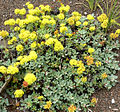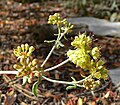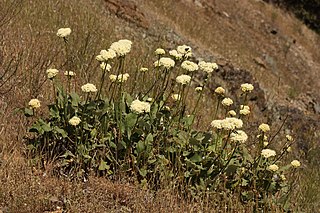
Eriogonum is a genus of flowering plants in the family Polygonaceae. The genus is found in North America and is known as wild buckwheat. This is a highly species-rich genus, and indications are that active speciation is continuing. It includes some common wildflowers such as the California buckwheat.

Eriogonum fasciculatum is a species of wild buckwheat known by the common names California buckwheat and flat-topped buckwheat. Characterized by small, white and pink flower clusters that give off a cottony effect, this species grows variably from a patchy mat to a wide shrub, with the flowers turning a rusty color after blooming. This plant is of great benefit across its various habitats, providing an important food resource for a diversity of insect and mammal species. It also provides numerous ecosystem services for humans, including erosion control, post-fire mitigation, increases in crop yields when planted in hedgerows, and high habitat restoration value.
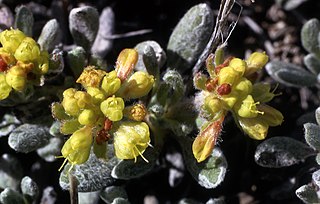
Eriogonum caespitosum is a species of wild buckwheat known by the common name matted buckwheat, mat buckwheat, or cushion desert buckwheat. It is a common perennial plant native to the western United States from California to Montana, especially the Great Basin. Flowering early in the summer, it is also cultivated as a rock garden plant.

Eriogonum ovalifolium is a species of wild buckwheat known by the common name cushion buckwheat. It is native to western North America from California to Alberta, where it is a member of many plant communities in varied habitats, including the sagebrush steppe and alpine regions.

Eriogonum strictum is a species of wild buckwheat known by the common name Blue Mountain buckwheat. It is a common plant of western North America from northern California to British Columbia where it is found along rocky slopes and scrubland. It flowers early in the summer.

Eriogonum wrightii is a species of wild buckwheat known by the common names bastardsage and Wright's buckwheat. It is native to the Southwestern United States, California, and northwest Mexico, where it grows in many plant communities, such as chaparral, in rocky habitats from mountains to deserts.

Eriogonum flavum is a species of wild buckwheat.
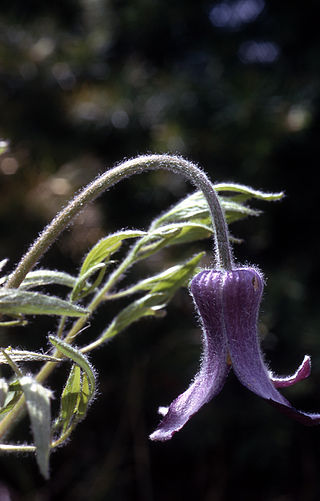
Clematis hirsutissima is a species of flowering plant in the buttercup family known by the common name hairy clematis or vase flower. It is a perennial herb that is native to much of the western United States, from Washington to Nebraska. It is a small, erect plant which, unlike other Clematis, does not generally produce vines. It is quite variable in appearance, especially across varieties. In general the hairy stem reaches up to about half a meter tall and has many large hairy leaves divided into lance-shaped lobes. The inflorescence appears at the tip of the stem and bears a solitary flower. The flower is made up of an urn-shaped cup of deep purple-blue petal like sepals, which are fuzzy and have pointed or rounded tips. Rare individuals have white or pinkish sepals. There are no true petals. The fruit is a hairy achene with a very long beak and a plume on the end; it is dispersed by wind.

Chrysothamnus viscidiflorus is an American species of shrub in the family Asteraceae known by the common names yellow rabbitbrush and green rabbitbrush.

Eriogonum heracleoides is a plant of western North America that has many flowering clusters which are usually cream colored, or off-white. It can usually be found in rocky areas, such as sagebrush deserts and Ponderosa pine forests. Parsnipflower buckwheat is in the genus Eriogonum and the family Polygonaceae, which is a family of plants known as the "knotweed family". It inhabits much of the western part of the United States and southern British Columbia.

Eriogonum brachyanthum is a species of wild buckwheat that is commonly known as shortflower buckwheat. It is native to eastern California and western Nevada, particularly the Mojave Desert region, where it is common to abundant, and even sometimes weedy. It is also known from southern Oregon. The plant grows in sandy habitats such as desert flats and sagebrush. It also grows in pinyon-juniper and montane conifer woodlands. It is an annual herb that grows 30 to 40 centimeters tall. Leaves are located at the base of the stem, woolly, and oval or rounded in shape. The top of the stem is occupied by a branching inflorescence bearing many widely spaced clusters of flowers. Each individual flower is about a millimeter wide and light yellow in color. Flowers bloom from April to November.

Eriogonum kennedyi is a species of wild buckwheat known by the common name Kennedy's buckwheat.

Eriogonum sphaerocephalum is a species of wild buckwheat known by the common names rock buckwheat and round-headed desert buckwheat. It is native to the western United States.

Callophrys sheridanii, the Sheridan's hairstreak and Sheridan's green hairstreak, is a butterfly in the family Lycaenidae. It is found in North America along the south coast of British Columbia and parts of Nevada, Arizona, Saskatchewan, North Dakota, and New Mexico. In 2009, this species was adopted as the U.S. state butterfly for Wyoming.

Eriogonum niveum is a species of flowering plant in the buckwheat family known by the common name snow buckwheat. It is native to the Pacific Northwest of North America, where it occurs in British Columbia, Washington, Oregon, and Idaho. It flowers late in the summer.
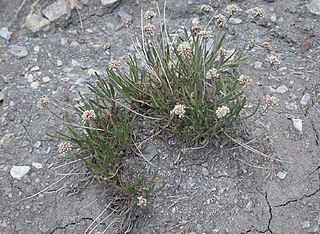
Eriogonum exilifolium is a species of flowering plant in the buckwheat family known by the common name dropleaf buckwheat. It is native to Wyoming and Colorado in the United States.
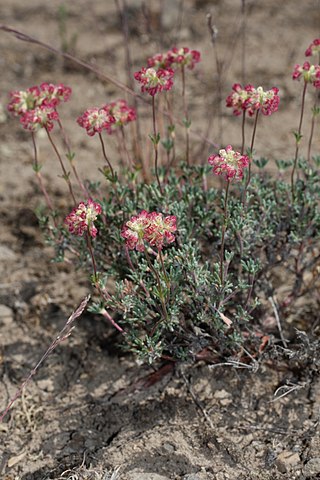
Eriogonum thymoides is a species of flowering plant in the buckwheat family known by the common name thymeleaf wild buckwheat, or simply thymeleaf buckwheat.

Castilleja integra, with the common names orange paintbrush, Southwestern paintbrush, and wholeleaf paintbrush, is a partially parasitic herbaceous perennial plant native to the Southwestern United States and Northern Mexico. The species produces a relatively large amount of nectar and is attractive to hummingbirds. It is better suited to cultivation than most other species in the paintbrush genus (Castilleja) and is therefore used in xeriscape gardens and naturalistic meadows, even outside its native range.

Eriogonum elongatum, commonly known as longstem buckwheat or wand buckwheat, is a species of wild buckwheat native to coastal southern and Baja California.



